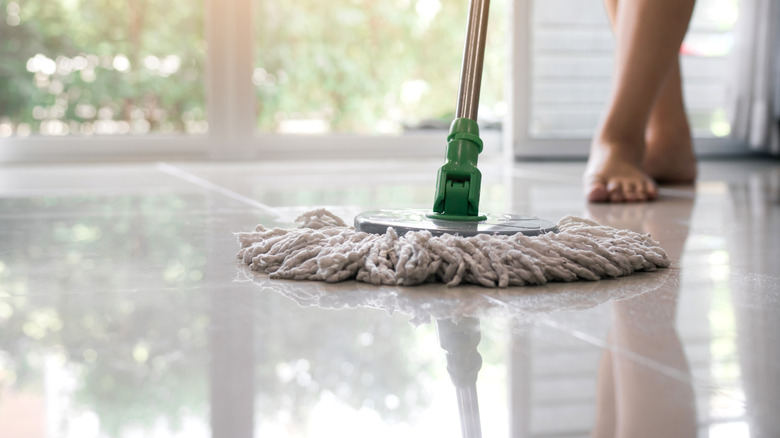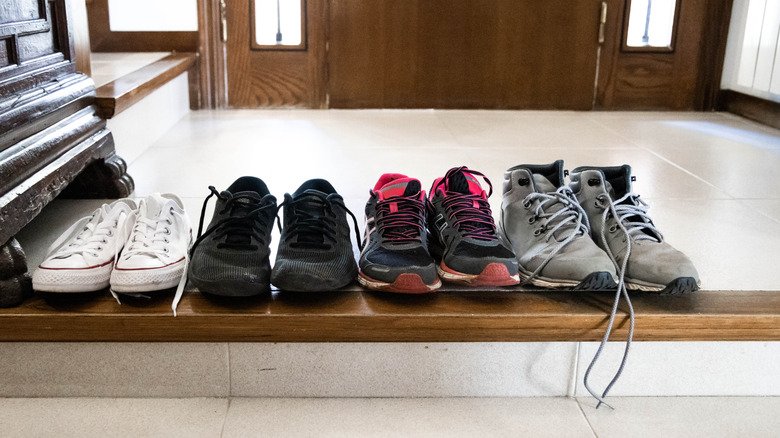How To Clean Marble Floors To Keep Them Sparkling And Streak-Free
We may receive a commission on purchases made from links.
It's hard to conceive of a more elegant floor than marble. Its subtle veining, durability, and polished translucent glow have been admired and desired for centuries. But cleaning marble floors well (and effectively) is key to its longevity. Often used in areas where water is evident, like bathrooms, showers, and kitchens, you'll also find it in stair treads and patio paving. It's as versatile as it is beautiful. And while marble has truly stood the test of time, there are some disadvantages to marble flooring to consider alongside the pros.
You might think a stone like marble is impervious, but unsealed, it's porous and can be stained by substances such as wine, coffee, tomato juices and even pet urine. That's why it is so important to have your marble sealed. If you wax your marble floor as your primary method of sealing it, use something like Trewax natural carnauba wax. Because the floors will need to be resealed every six to 12 months, professional products that require less upkeep are a good choice. Once sealed, mop up spills quickly with a soft cloth.
One other potential downside to marble is that when it is highly polished, it can be slippery while cleaning it — so be careful. Finally, marble is one of the most expensive floor covering materials. Which is an important reason to take of it properly and clean it so that it stays sparkling and streak-free. Luckily, it's easy to do. Just sweep, vacuum, then follow up with a mixture of pH-neutral soap and water to clean. Use a soft mop to avoid floor scratches.
The best way to clean marble floors
Once your marble floors are properly sealed, cleaning them is a basic four-step process. Remember that even though marble is literally stone, it is porous and can be scratched and abraded. Also, stay away from ammonia or vinegar cleaning products, and absolutely no bleach. Don't use Clorox wipes on marble! Start the floor-cleaning process by clearing the area of any furniture. Lift those furniture pieces — don't slide. With a soft bristle broom, sweep the floor completely. Follow that up by vacuuming gently without using a beater bar.
Next comes mopping and buffing. Prepare two buckets of water, one with a few drops of pH-neutral soap. Grab a microfiber cloth or two. Is Dawn dish soap safe on marble? Sorry, no. But a commercial cleaner like Black Diamond Stoneworks marble and tile cleaner or a soap like Dr. Bronner's should work if you're not sure. Fill the other bucket with clean water.
Use a soft fabric mop made from cotton or microfiber to work a small area of the floor with the soap solution in a circular motion. There is no need to flood the area; just use a damp mop. Follow up by rinsing the area with the clean water and buff it dry with a microfiber cloth ... then move onto the next area. That kind of buffing action is what will shine your marble. It's the right way to polish marble floors to a streak-free finish.
Avoid these mistakes when cleaning marble floors
Here are a few tips and tricks to keep your marble floors in tip top shape. Do not use alkaline or acidic detergents. Vinegar will actually stain marble. You may wonder how often you should be cleaning your marble floors. Once a week is a good idea according to most flooring experts. If you have children and pets, you may need to do it more often.
Seal your floors every eight to 12 months, but it'll be more frequent, every six months, if you are using a wax-based sealer. Avoid wearing shoes on your marble, as they track grit and dirt into the house. Grit is especially hard on marble due to its porous nature — and dirt can stain marble. Consider making your house a shoe-free zone. And if you have pet dogs, keep those toenails trimmed short. They can scratch the marble.
Avoid mops with abrasive strips on them. Cotton or microfiber mop heads are the way to go. As mentioned, avoid vacuums with beater bars, but especially those that have hard plastic wheels that could scratch the marble. If you have a soft brush attachment, use it on your marble floors. Felt pads on the legs of your furniture are a must, and judicious use of area rugs will protect high-traffic areas. Marble floors can last a lifetime if well cared for. And if they do get damaged or abused, as a last resort they can be restored by professional floor polishers. That will probably be an expense that most homeowners would like to avoid, though.


